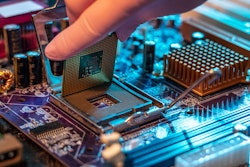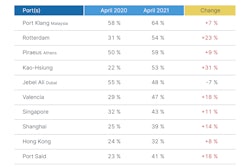
A black swan occurrence is an unpredictable event with a low probability, but a high impact of occurring. The Coronavirus disease (COVID-19) pandemic is one example of a black swan event.
Black swan events will continue to increase given the nature of pandemics and climate change. And, like other catastrophes, supply chains are vulnerable to these occurrences. One reason is because they are deeply entwined, integrated and dependent globally with the resulting disruptions having a ripple effect, both upstream and downstream.
Lay of the land
Growing environmental awareness has prompted more and more upstream sourcing methods to focus on ethical practices. Downstream, there is a need for increased visibility in order to customize and enhance analytics. A product that has been improved reduces the dependency on the supply chain and makes it more resilient.
To shore up the reliability of their supply chains, companies need to address and mitigate potential internal (demand planning) and external (black swan events) risks. While companies cannot be 100% certain of the demands they will face for their products, they can use algorithms based on usage data generated by market trends for their products.
Supply chain technologies
To ensure the reliability and improve the resilience of their supply chains, here are seven key technologies that companies should embrace.
1. Digital twin, sensors and Internet of Things (IoT). A digital twin is an end-to-end digital avatar of the value chain in the company that gives management better visibility, control and agile executability. The digital warehouse management system is a very small component and just one part of the digital twin. The digital twin is akin to the avatar of the physical supply chain in the digital world. It can be better controlled, is more agile and responsive to the external threats. Also, it allows for s better visibility when it comes to emerging threats arising out of a node or links in the chain. Anything that can be seen or measured better may be addressed or controlled better and therefore having the demand metrics, material sources, suppliers, manufacturing pipeline, inventory as well as transport management as integrated system applications provides the contemporary businesses with better efficiencies and reduced inherent risks.
Sensors are the digital eyes, ears and touchpoints that gather data that allows the digital twin to be alive and responsive in real time. An example would be the suite of cameras on a traffic signaling system that can provide real-time information to plan the most optimal routes for last-mile delivery. The sensors can broadcast raw data or cost effectively may edge compute on the device before broadcasting.
The IoT is transforming the supply chains into a live seamless and inter-connected line wherein the nodes (sources upstream, tiered suppliers, manufacturing entities and retailers) as well as the machines talk amongst each other. This machine data is critical for analyzing emerging risk patterns or for assessing and control of the flow of materials and information in the chains.
2. Predictive and prescriptive strategies and analytics/Big Data. Predictive data analytics are derived not only from humans and the digital twin, but also from digital machines. Sensors on these machines allow them to talk to each other. Big Data neural networks are crucial to the supply chain because they allow for calculations that humans are simply unable to do. By combining the digital twin with Big Data, companies can make myriad predictions. Predictive analytics enable companies to forecast sales figures based on inventory and then further capture data on specific regions.
3. 5G/satellite link. 5G can help the digital twin by allowing workers in the field to sync data in real time. For example, 5G enables virtual reality or augmented reality in cars, thereby opening a whole new world in infotainment. 5G also can be used in warehouses by updating data in real time via virtual glasses worn by employees, showing them exactly where and when to move a pallet, thereby removing the need to read a barcode on a container.
4. Blockchain. Blockchain can be applied to supply chains to create an audit trail of transactions and automate processes through smart contracts. It can improve the transparency, accountability and efficiency of current supply chains. For example, when it comes to electric cars, the battery is the most expensive part and companies can use the blockchain technology to ethically source these batteries. Doing so can also bring down both the price of the raw materials and the costs of the car.
5. Artificial intelligence (AI) and demand planning. Demand planning is a crucial part of supply chain management, where human knowledge matters. Also, demand forecasting is deeply connected to inventory management because of its impact on replenishment schedules, production arrangements and delivery plans. Historically, however, it has been characterized by heavily manual work and ineffective information system handling. Today, the complex demand planning process includes not only the overall information integration and interpersonal communications, but also the IT systems’ interaction and technologies. Machine learning (ML) and AI are reshaping the way companies operate. Collaboration is migrating from strictly human interactions to include interface between humans and machines. Mundane and repetitive tasks will be done by machines automatically, while humans can develop insights and make wise decisions supported by data streaming from intelligent machines. The outcome contributes to a more accurate demand forecast result, so that companies can further improve customer-specific order service levels, inventory efficiency, turnover rates, and even customer sales.
6. Autonomous-driven semi-trucks and last-mile delivery loads. Today, there is a huge shortage of drivers, which in turn impacts the supply chains. That said, semi-autonomously driven trucks that are currently being used by several major companies will mitigate the shortage of drivers and supply routes. These trucks are more fuel efficient because they require no human intervention, can run at a constant speed and can be platooned, which can save fuel costs by up to 30%. Currently, last-mile delivery is often not cost-effective. It is one of the biggest problems in the supply chain today. While companies are still working on strategies, the ideal goal is for autonomous vehicles to be programmed for this task.
7. 3D printing. The use of 3D printing is a boon in the manufacturing chain because of its flexibility in shape, design and storage of digital designs. It blends the ability to produce customer-specific products with the low per-unit cost of mass-manufacturing. Without 3D printing, it could take weeks or more to replenish supply.
An investment worth making
The upfront costs to implement supply chain technology is heavy. But, sustainability should never be evaluated on the face value of capital investments. Instead, conduct audits over the long-term generation of revenue to ensure that these technologies are delivering the intended value for the company.
In the wake of the COVID-19 pandemic and the ongoing risk of future black swan events, the mandate for companies to look for solutions to prevent supply chain disruption is great. These seven key technologies offer are an opportunity to do just that.















